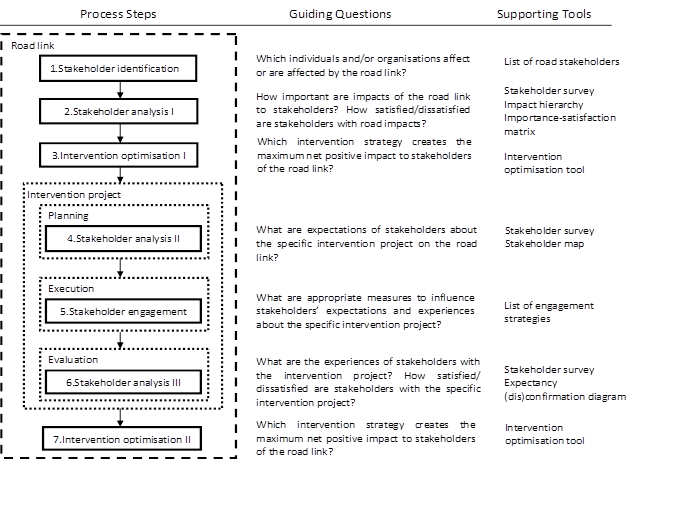The project “Stakeholder Benefit and Road intervention Strategies” (SABARIS) aimed at supporting the decisions-making at road agencies on the determination of an optimal intervention strategy for a road link considering the varying and sometimes conflicting values of road impacts for road stakeholders. Based on literature and case study research SABARIS developed and tested a guideline and a number of tools to provide this support. Although the tools can be used alone, it is particularly their combination of stakeholder management, traffic management and intervention optimization which can advance the management of road infrastructure.
The SABARIS project has shown that the satisfaction of road stakeholders is not a matter of either managing stakeholders during intervention projects or selecting an intervention strategy with the lowest life cycle costs. Rather, the satisfaction of road stakeholders depends on an intervention strategy that maximizes the net positive impacts (or benefits) of road infrastructure and the perception of stakeholders that during the execution of this strategy the benefits are achieved. That guideline and tools can provide road agencies this combined value in decision-making has been shown through the two case studies, one in the Netherlands and one in Belgium. The case comparison revealed that an optimal intervention strategy is not sufficient to satisfy stakeholders and that an optimal approach during intervention, leading to satisfied stakeholders, is not necessarily the optimal approach over the whole life cycle of road infrastructure.
Based on a comprehensive literature study and two in-depth case studies in the Netherlands and Belgium SABARIS achieved its objective by producing a number of results that will be of immediate use to infrastructure managers in European road agencies:
Guideline for stakeholder oriented optimisation of road intervention strategies
The guideline describes a 7-step process road agencies should follow when determining the optimal intervention strategy for a road link taking the valuation of road impacts by stakeholders into account.
- List of road stakeholders
The list of road stakeholders helps road agencies in identifying critical stakeholders of a particular road link. It categorizes road stakeholders into four groups: directly affected stakeholders, indirectly affected stakeholders, directly affecting stakeholders, and indirectly affecting stakeholders. - Impact hierarchy
The impact hierarchy helps road agencies in defining the impacts to be considered when defining intervention strategies and can assist in determining the information needed for the valuation of the impacts. It subdivides road impacts on stakeholders (e.g. safety, travel time, comfort) at increasingly fine levels until impacts can be reasonably and objectively quantified and modelled. - Stakeholder survey
The stakeholder survey helps road agencies in revealing the importance of road impacts to stakeholders and the expectations, experiences and satisfaction of stakeholders related to an intervention project. - Importance-satisfaction rating/matrix
Importance-satisfaction rating and matrix help road agencies in determining the intervention priorities of road impacts by relating the importance of road impacts to stakeholders and the satisfaction of stakeholders with these impacts. - Expectancy (dis)confirmation diagram
The expectancy (dis)confirmation diagram helps road agencies in determining the combined influence of stakeholder expectations and experience on the satisfaction of stakeholders with intervention projects. - List of engagement strategies
The list of engagement strategies provides road agencies with an overview of possible ways to influence stakeholder expectations about and experience of intervention projects and, by doing so, to attain satisfied stakeholders. - Optimisation tool
The optimisation tool is a simple prototype of an user-friendly interface which allows to estimate the optimal intervention strategy for a road link based on a deterministic optimisation model. Results of estimation can be recorded on screen or into flat files and being used in other software for graphical demonstration.
Guideline for stakeholder optimized road intervention strategies


The two case studies in the Netherlands and Belgium were used to develop and test the aforementioned guideline and tools. Important insights generated by the case studies are:
- Road impacts can be important to all stakeholders
Both cases suggest that all road stakeholders judge a number of road impacts as being important. These impacts include safety, travel time, economy, and comfort. The importance of these impacts is related to the groups that were involved in the case studies: road users, residents and companies. This result shows that individuals and organisations adopt different stakeholder roles. Particularly residents and companies are also road users of the investigated highway links which makes safety, travel time and comfort important impacts for all stakeholders. Depending on the satisfaction with the four impacts intervention strategies and projects should focus on keeping these impacts on a certain level or improving them.
- The importance of road impacts between stakeholder groups can differ
Although some impacts are important to all stakeholders, the ranking of impacts can differ between stakeholder groups. Travel time and vehicle cost are very important impacts for road users and companies. Emission is an important impact for residents and economy is an important impact for companies. These differences can lead to different intervention strategies depending on the satisfaction of the stakeholder group with the impact and the position of the group in the context of the particular road link. The only exception is safety which is the most important impact for all stakeholder groups.
- Stakeholder experiences are more important for the satisfaction with an intervention project than expectations
Both cases point out that experiences are more important for the satisfaction of stakeholders with an intervention project than expectations. That includes experience with the process, the outcome and the information provision of the project. An implication for road agencies is to put more emphasis on a noticeable positive experience of process, outcome and information provision of an intervention project. That also means that the engagement with stakeholders is not only crucial before but also during the project. At a basic level stakeholders should receive enough information about the project to be able to make decisions, for example, about their travel behaviour.
- Satisfaction with the outcomes determines the overall satisfaction with an intervention project
The outcome of an intervention project is decisive for the overall satisfaction with the project. In both cases the overall satisfaction of stakeholders was mainly influenced by the satisfaction with the intervention outcome. It seems essential to improve road infrastructure in a way that the improvement can be clearly experienced by stakeholders and any inconvenience faced during the intervention project is outweighed. That may also include keeping stakeholders up to date about the intervention process and the intended improvements on the road during the project.
- Stakeholder management has an effect on the satisfaction of road stakeholders with an intervention project
The results of both cases suggest that engagement with stakeholders will have an influence on the satisfaction with an intervention project. In the Dutch case the road agency took a lot of effort to inform stakeholders but also to communicate with the stakeholders about the project. The stakeholders were much satisfied about process and information provision of the project. In the Belgian case the information was restricted to a few selected groups which resulted in unsatisfied stakeholders that were not involved. An interesting questions emerging from this finding and related to the costs associated with engagement strategies is: what is the appropriate level of engagement to ensure satisfied stakeholders?
- An optimal intervention strategy does not guarantee satisfied stakeholders
A conclusion related to the previous one is that an optimal intervention strategy is not sufficient for having satisfied stakeholders. In both cases the intervention strategy applied corresponded with the optimal strategy estimated for the period during intervention. However, in the Dutch case stakeholders appeared to be more satisfied than in the Belgian case with the intervention project. In other words, although the maximum net positive impact for stakeholders was achieved, stakeholders were not necessarily satisfied in the Belgian case. Intervention strategy and stakeholder management are two sides of the same coin ensuring stakeholder satisfaction with road intervention projects.
- An optimal intervention strategy during intervention is not necessarily the optimal intervention strategy overall
As mentioned before, in both cases the intervention strategy applied was in line with the optimal strategy estimated for the period during intervention. In this sense, both agencies succeeded in selecting the strategy with the lowest overall costs during intervention. However, when taking the costs between interventions into account the optimality was changing for the Dutch case. Another strategy than the one applied became optimal. The reason for the change lies in the deterioration and impact development between interventions which suggests different intervention times. The implication is that the planning of an intervention project should be always based on the underlying optimal intervention strategy.
- The optimal intervention strategy depends on impact values and model parameters
Which intervention strategy becomes optimal depends on the impact values and model parameters that are used to estimate the costs. The sensitivity analysis showed that changes of impact value and model parameter can lead to another optimal strategy. Clearly, the optimal intervention strategy was not sensitive to all impacts and for some impacts the optimality only changed for larger values. However, impact values and parameters should be carefully selected and critically reviewed. A sensitivity analysis is always recommended to investigate the stability of the optimal strategy.
- Guideline and tools for stakeholder oriented optimization of road intervention strategies are valuable for road agencies
The case studies but also the workshop held with practitioners from the Dutch Highways Agency revealed that guideline and tools can provide valuable information for the decision making at road agencies. Although the tools can be used alone, it is particularly their combination of stakeholder management, traffic management and intervention planning which can advance the management of road infrastructure.

